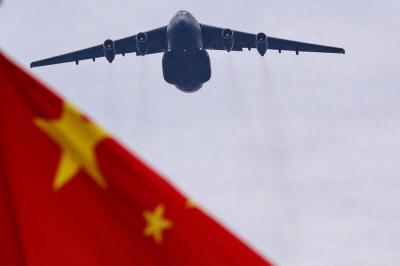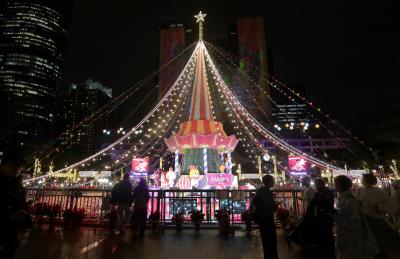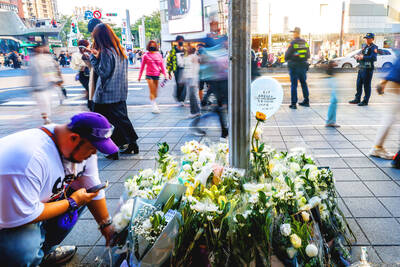Legislators yesterday urged the Ministry of Transportation and Communications (MOTC) to address the issue of the fifth freedom of the air for cross-strait flights in negotiations with China over an economic cooperation framework agreement (ECFA).
The fifth freedom of the air would allow Taiwanese carriers to fly on to other nations after arriving at airports in China, and vice versa.
Chinese Nationalist Party (KMT) legislators Yang Li-huan (楊麗環) and Chu Fong-chi (朱鳳芝) suggested that the ministry take the opportunity presented by ECFA talks to discuss the matter.
Chu said Taiwan and China had failed to reach a consensus on the fifth freedom at previous cross-strait talks because if China agrees to the fifth freedom, it could risk Chinese carriers losing some customers to their Taiwanese counterparts.
MOTC Deputy Minister Yeh Kuang-shih (葉匡時) said the ministry could make policy suggestions to the Mainland Affairs Council (MAC) and recommend that it list the issue on the agenda for talks with Chinese officials if “it is in the best interest of Taiwan.”
Democratic Progressive Party (DPP) Legislator Yeh Yi-jin (葉宜津), on the other hand, said that the ministry should work to gain observer status for Taiwan in the UN International Civil Aviation Organization.
The proposals were put forward at a meeting of the legislature’s Transportation Committee to review the Civil Aeronautics Administration’s (CAA) budget for the 2010 fiscal year.
Aside from the matter of cross-strait flights, some legislators also criticized the CAA for what they said was a lackluster performance by Taiwan Taoyuan International Airport.
A report by Airports Council International (ACI) ranked the airport 18th in the Asia-Pacific region last year in terms of flight passenger volume, down from 14th in 2007.
Lawmakers said there were shortcomings in the airport’s infrastructure. They also suggested that the MOTC dismiss flight control personnel at airports that have relatively low usage rates.
DPP Legislator Kuo Wen-chen (郭玟成) said some airports, such as Pingtung’s, have a usage rate of about 1 percent since the launch of the high-speed rail.
Yeh Kuang-shih said the ministry would review the operations of all airports nationwide.

Beijing could eventually see a full amphibious invasion of Taiwan as the only "prudent" way to bring about unification, the US Department of Defense said in a newly released annual report to Congress. The Pentagon's "Annual Report to Congress: Military and Security Developments Involving the People's Republic of China 2025," was in many ways similar to last year’s report but reorganized the analysis of the options China has to take over Taiwan. Generally, according to the report, Chinese leaders view the People's Liberation Army's (PLA) capabilities for a Taiwan campaign as improving, but they remain uncertain about its readiness to successfully seize

Taiwan is getting a day off on Christmas for the first time in 25 years. The change comes after opposition parties passed a law earlier this year to add or restore five public holidays, including Constitution Day, which falls on today, Dec. 25. The day marks the 1947 adoption of the constitution of the Republic of China, as the government in Taipei is formally known. Back then the Chinese Nationalist Party (KMT) governed China from Nanjing. When the KMT, now an opposition party in Taiwan, passed the legislation on holidays, it said that they would help “commemorate the history of national development.” That

Taiwan has overtaken South Korea this year in per capita income for the first time in 23 years, IMF data showed. Per capita income is a nation’s GDP divided by the total population, used to compare average wealth levels across countries. Taiwan also beat Japan this year on per capita income, after surpassing it for the first time last year, US magazine Newsweek reported yesterday. Across Asia, Taiwan ranked fourth for per capita income at US$37,827 this year due to sustained economic growth, the report said. In the top three spots were Singapore, Macau and Hong Kong, it said. South

HORROR STORIES: One victim recounted not realizing they had been stabbed and seeing people bleeding, while another recalled breaking down in tears after fleeing A man on Friday died after he tried to fight the knife-wielding suspect who went on a stabbing spree near two of Taipei’s busiest metro stations, Taipei Mayor Chiang Wan-an (蔣萬安) said. The 57-year-old man, identified by his family name, Yu (余), encountered the suspect at Exit M7 of Taipei Main Station and immediately tried to stop him, but was fatally wounded and later died, Chiang said, calling the incident “heartbreaking.” Yu’s family would receive at least NT$5 million (US$158,584) in compensation through the Taipei Rapid Transit Corp’s (TRTC) insurance coverage, he said after convening an emergency security response meeting yesterday morning. National